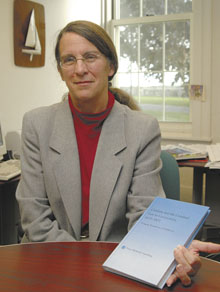  |
| HOME | THIS ISSUE | CALENDAR | GRANTS | BACK ISSUES | < BACK | NEXT > |
Changing perceptions of childhood explored in book on children and lawby Leslie Virostek - November 7, 2005 |
||||
|
“If any man have a stubborne and rebellious sonne of sufficient years and understanding, viz. sixteen yeares of age, which will not obey the voice of his father or the voice of his mother … such a sonne shall be put to death.” So says The Code of 1650, a compilation of early Connecticut laws. Historian Nancy Steenburg says it is unsettling to find that stubbornness in a 16-year-old was a capital crime, but it is also notable that, in looking through thousands of court cases, she never found any in which a rebellious son was put to death. That the statutes on the books did not reflect what was happening in the court cases was one of the major themes of Steenburg’s research into Connecticut’s legal history with regard to minors. Her findings appear in a new book called Children and the Criminal Law in Connecticut, 1635-1855: Changing Perceptions of Childhood. While other researchers have drawn conclusions from looking at Connecticut statutes, Steenburg brings to light new information by closely analyzing hundreds of court cases involving minors. The result is a more detailed, more nuanced interpretation of the legal treatment of children who were accused of theft, arson, murder, and breach of public order, and who were victims of physical and sexual abuse. One of Steenburg’s main goals with the work is to debunk the popularly held notion that children in colonial times were treated as “little adults” after the age of seven. It’s an impression conveyed by portraiture of the seventeenth century, in which children under the age of seven are seen in shifts, with long hair. Children older than seven are portrayed as little men and little women in miniature adult clothing. In her introduction to the book, Steenburg notes that while the modern “cult of the child” began with the ideas of Jean-Jacques Rousseau in the mid-1700s, allowances were made for children’s special status 100 years earlier. “I found cases going back to the 1600s where there was differential treatment for children; there was a recognition that you couldn’t treat a child, even over the age of seven, the same way you could treat an adult,” says Steenburg. “The book is an attempt to try to prove that there were different assumptions about children’s legal understanding, and therefore children were held to different standards of behavior.” Steenburg further argues that understanding how a society treats its least powerful members is crucial to understanding that society as a whole. For example, she traces the gradual evolution of what became the nature-nurture debate. “Connecticut was Puritan, and in the 1600s, the thinking was that children were evil – everyone was evil – and totally soaked with original sin,” she says. “By the 1700s, there’s a softening of that. I theorize in the book that it’s partly the influence of the Enlightenment.” Moving toward the 19th century, the pervasive belief was that children who did not receive the proper moral upbringing could not be held responsible for their actions. Steenburg’s book also discusses the specifics of how children were punished. Although children often received different or lesser punishments than adults committing the same kinds of crimes, up until 1828 the only prison in the state was Newgate, where children were imprisoned with adult criminals. In the early 1800s, the public began to believe that this situation was untenable, despite the need to punish children for their crimes.
Says Steenburg, “Juries began to find children not guilty in cases where they seemed very, very guilty.” When the new state penitentiary in Wethersfield opened in 1828, it offered separate rooms and opportunities for education for children. But it quickly became overcrowded, leading to “battling petitions” in the legislature. Some called for the creation of a reform school for children. Others called for “discretionary sentencing,” which would enable children to serve their sentences at the county jail, closer to home, so they could receive visits from family and friends or a minister. Choosing the less expensive option, the state began to allow discretionary sentencing. But, notes Steenburg, county jails were not much better than the prison. It wasn’t until the 1850s that the state finally built its reform school. Dissatisfaction with the way the state handles youth offenders, notes Steenburg, is still with us today, as is the debate about what children of various ages can be held accountable for. Steenburg, who once considered a career as a lawyer, has long been interested in how and why the law evolved the way it did. Her first exposure to colonial era legal records came when she was earning her master’s degree from Trinity College. Her thesis explored the causes and impact of “an explosion of litigation” in Windham County in the 1740s. Later, as a Ph.D. student at UConn, she took a course on “The History of the Family,” which led to research on children and criminal law, a dissertation on the topic, and finally this book. The actual research, Steenburg says, was quite grueling. For five years, she spent two or three days a week at the State Library, sifting through thousands of court documents. Though she generally focused on New London County, that County Court met twice a year, sometimes with as many as 600 cases per session. What’s more, the cases were not indexed or sorted. She had to read well beyond the summaries to discover whether a particular case involved a child defendant. She often found herself poring over original documents of crumbling parchment, written with brown vegetable ink. “I found it absolutely fascinating,” she notes, “especially the voices of the children that came through, and the attitudes that haven’t changed in 300 years.” |
| ADVANCE HOME UCONN HOME |

